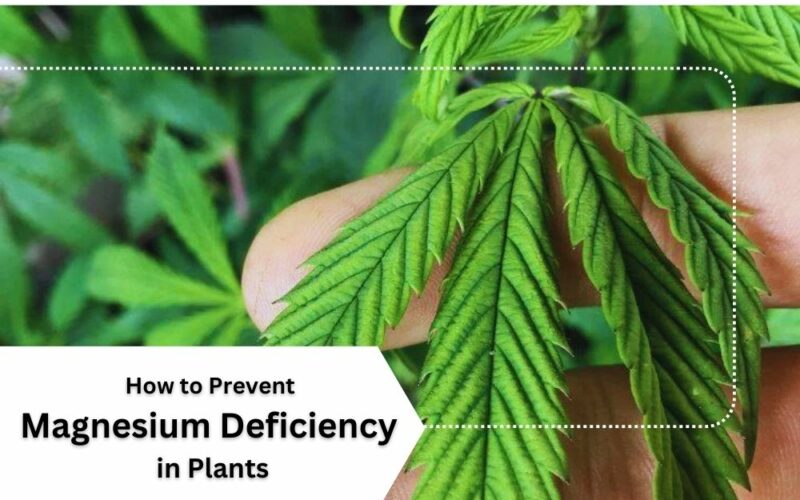Join this post to find out the causal agents of Mg shortage and learn how to prevent magnesium deficiency in plants.
I’m a horticultural advisor and my academic major is plant protection; I strongly believe that prevention is always easier and more effective than treatments. But people often don’t know how to prevent nutrition deficiency in plants before any damage.
Magnesium shortage in plants is one of the challenges of indoor and outdoor gardeners (or farmers) often ask me. I told you about the Magnesium deficiency in palm trees in my previous article. Here, I want to tell you how to prevent Magnesium deficiency in plants by discussing the factors that cause it and giving solutions to fix them.
Before starting, let’s find out what is magnesium deficiency in plants. if you know it, jump to the next part.
➡ You can also hear the audio version of this article.
What Is Magnesium Deficiency in Plants?

Magnesium is one of the macronutrients that plants uptake from the soil. It plays several critical roles in plants including:
- Mg is a critical element in chlorophyll molecules and, as you know, chlorophyll is essential in the process of photosynthesis.
- Mg is involved in the function of several botanical enzymes.
Hence, a shortage the Mg in soil will destroy the plant photosynthesis and some metabolic reactions. But what is magnesium deficiency in plants and what causes it?
Symptoms of Magnesium Deficiency in Plants.
The most common signs of magnesium deficiency in plants are yellow discolouration in the old leaves between the veins and around the leaf edges while the veins remain green.
Magnesium Deficiency vs. Iron Deficiency:
Some people mistake a magnesium deficiency for the symptoms of a starting iron deficiency. You must note that Mg is a mobile macronutrient, so, you spot the symptoms of magnesium deficiency in old leaves of plants (because Mg will transfer from old leaves to young leaves). But Iron is an immobile micronutrient, so, the young leaves will show the first symptoms of iron shortage.
I discussed the function of Magnesium in plants and its deficiency in my other article “Is magnesium good for plants?” in detail.
What Causes Magnesium Deficiency in Plants?
Whilst Magnesium is the 8th most abundant mineral element on earth, plants may encounter magnesium deficiency. Do you know why? In the following, I will highlight the most important conditions that lead to magnesium deficiency in plants
➡ To prevent everything, the first step is finding the factors that can cause it.
several factors can cause Magnesium deficiency in plants and after you find out them, you can design a strategy to prevent the problem. Let’s find them.
1- Absolute Deficiency of Magnesium in Soil Can Cause Magnesium Deficiency in Plants.
As mentioned above, Magnesium originates from source rock in various types such as silicate or carbonate minerals and the amount of magnesium is different in them. several factors play a role in this issue including:
- The distribution of the magnesium minerals in source rock
- The grade of weathering in various areas makes Magnesium minerals usable for plants.
Hence, some soils have an absolute deficiency of magnesium, and plants growing in them will show the symptoms of Magnesium deficiency. In this situation, the only way is to improve the soil by adding Magnesium fertilizers.
➡ Plants may show signs of Magnesium deficiency in soils with high amounts of Magnesium! Why? Keep reading.
2- A Low pH value in Soil Can Cause Magnesium Deficiency in Plants.

Ever wondered about the role of PH in uptaking soil elements by plants? PH has several impacts on Magnesium deficiency in plants.
A: Various elements in soil are absorbed by plants at different PH levels. For example, the soil may have enough Magnesium but its absorption rate by plants will be decreased in low PH values.
Research shows that the symptoms of magnesium deficiency in plants are most common in acidic soils.
B: PH has another effect on Magnesium deficiency in plants. In acidic soils, the rate of Magnesium leaching will increase in considerable amounts. Hence this element will easily become unavailable for plants.
C: PH also has an impact on root elongation. Based on the research, the root elongation will be limited in low PH and a limited root system will work weakly in absorbing nutritional elements such as Mg.
3- Cation Competition in Soil Can Cause Magnesium Deficiency in Plants.

Excess amounts of some nutrients in the soil can decrease or even band the absorption of Mg by plants, hence you will spot Magnesium deficiency symptoms. we call this phenomenon an “unbalanced soil nutrient composition”.
For example, the high availability of the cations such as Ca, K, N, Al, and Mn in soil, will prevent the absorption of Mg by plants.
However, some research showed by increasing the amount of Phosphorus in the soil, the absorption of Mg will be increased by plants.
4- The Dried Soils Can Cause Magnesium Deficiency in Plants.
Please note that humidity plays like a double-edged sword. Soil elements need humidity to transfer to plants and in drought conditions, their delivery to the roots won’t work well, hence in dried soils, the transport of Mg to the roots can be impaired.
In addition, the Magnesium elements in the source rock must be subjected to weathering to become available for plants. The grade of weathering in humid conditions is higher than in dried environments.
On the other hand, in soils with high-leaching water, you will spot a high-leaching Mg too. In addition, in waterlogged soils, the root’s elongation will be decreased which will have an impact on absorption of Mg and other elements by roots. You spot it often in plants that grow in pots without holes. If you are interested in planting into cachepots, read my article about the best practice for watering plants in pots without drainage holes.
5- Low Soil Temperature Can Cause Magnesium Deficiency in Plants.
The result of research on tomato plants showed that the absorption of Mg by plants can be subject to soil temperature. In warm soils, uptaking Magnesium will be increased however it will be decreased in cold seasons like autumn and winter.
It’s likely due to the effect of cold temperature on transpiration inhibition. As you may know, transpiration from leaves is important in absorbing water and elements from soil.
6- High Light Stress Can Cause Magnesium Deficiency in Plants.
Research showed that the plant’s requirement for Mg will be increased under high-light conditions. based on the results, under high light and low Mg, the accumulation of reactive oxygen species (ROS) in plants will increase which will lead to plant damage.
7- Sandy Soils with Low CEC Can Cause Magnesium Deficiency in Plants.
The amount of leaching Magnesium from soil will increase in sandy soils with low CEC. So, plants will show the symptoms of Magnesium deficiency. Soils with high amounts of clay and organic matter content can save more amount of Mg.
How to Prevent Magnesium Deficiency in Plants?
After you find out the factors that cause Magnesium deficiency in plants you can design a strategy to prevent it. how? keep reading. You must consider the above factors in your plant environment and investigate which ones can cause Magnesium deficiency in your plants. for example, check the PH of soil or analyze its elements. Let’s discuss them in detail.
1- Investigate the Soil Composition to Prevent Magnesium Deficiency in Plants.
The most common compounds of soil are minerals (clay, silt, and sand), organic matter, water, and air. The clay and organic matter content of soil have an impact on most factors that can cause Magnesium Deficiency in Plants, including:
- The cation exchange capacity
- The amount of leaching water
- The Ca concentration (liming)
- The soil acidity (the presence of H+ ions)
- The bicarbonate (HCO3 −) concentration
So, to prevent Magnesium deficiency in plants you must avoid planting in sandy soils with low CEC and you should increase the amount of organic matter in the soil.
2- Check the Soil’s PH to Prevent Magnesium Deficiency in Plants.
As mentioned above, in soil with a low PH value, the absorption of Mg by plants will be decreased. The best soil Ph for uptaking Mg is between 7 to 8.5. But the best soil PH for different Micro and macro elements of soil vary.

Hence, if you increase the PH value of soil, other elements (especially micronutrients) for your plant may not be as available as before and your plant may show the symptoms of other nutrient deficiency. So, what must you do? Please note to the above picture, that the best soil PH for absorbing the most nutritional elements is between 6 to 7.5. So, if you set the soil PH in this range, you will ensure that PH never limits nutrient absorption.
3- Measure the Amount of the Soil Elements to Prevent Magnesium Deficiency in Plants.
It’s important for two reasons:
A: Detect the Absolute Deficiency of Magnesium in Soil. If the result of the soil analysis shows a magnesium deficiency, you must add Mg fertilizers to raise its amount in the soil. Before using Magnesium fertilizers, you should note the PH of the soil. For example, in acidic soils, you should apply dolomitic limestone to raise the PH and increase the Mg content Simultaneously.
B: Prevent of Cation Competition in Soil. Pay attention to the amount of Ca, K, N, Al, and Mn in soil, the high level of these cations will decrease the absorption of Mg. Most of the time, using NPK-dominated fertilizers along with neglecting Mg will lead to unbalancing in soil elements.
4- Pay Attention to Soil Humidity and Temperature to Prevent Magnesium Deficiency in Plants.

As you found out above, the absorption of Mg will be decreased in drought or cold conditions. so, you should provide enough water for your plant and try to warm the soil.
In addition, your plant must live inside soil with enough oxygen content to improve its root system. You will find it very important for uptaking Mg and other nutrient elements by plants.
Conclusion
Magnesium is a mobile macronutrient that plays a critical role in producing the chlorophyll pigment in plants and causes the green colour of leaves, hence its shortage will lead to the yellowing of old leaves while their veins are still green. So, Magnesium deficiency in plants will lead to stop growth.
Hence, it’s important you can prevent Magnesium deficiency in plants. here, I provided you with 7 factors that can cause it and told you how to fix them to prevent magnesium deficiency in your garden (indoor or outdoor) or farm.
Did you detect what will cause magnesium deficiency in your plants? how do you want to prevent it? You can ask me if you have any questions. I will answer as soon as possible. In addition, if you cannot detect your plant problem, take a clear picture and send me (inhouseplant2017@gmail.com), please tell me about it too below this page to find your mail quickly, I receive a lot of emails every day.

Elahe Rabiei
Hi, I’m Elaheh. My Academic major is plant protection, and houseplants are my expertise. As a houseplant lover, my house is full of indoor plants and it is my passion to take care of them. Hence, I’m here to share my knowledge and experience about growing healthy houseplants. I am also a plant protection advisor, so feel free to ask me any questions you may have.

